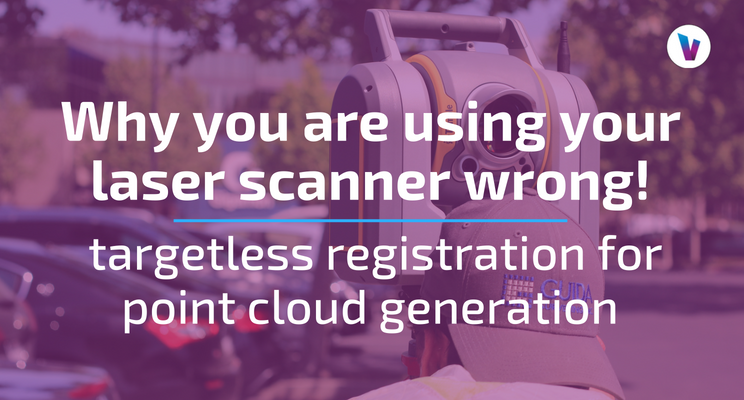Why you are using your laser scanner wrong!

Laser scanners have played an important role in engineering since the late 1990s. Laser scanner technology continues to advance in tandem with developments in computing capabilities — following the trajectory of many technologies to become cheaper and easier to use. The process, however, of laser scanning has remained fundamentally unchanged — until now!
How LiDAR (Light Detection and Ranging) has historically functioned
Laser scanners must make line-of-sight measurements, meaning that multiple scans are regularly required to produce a 3D image. Objects normally need to be scanned from several angles in order to allow downstream processing to accurately depict a scene. For large projects, dozens, hundreds, or even thousands of scans are required in order to cover the entire area.
A ‘target registration’ process is required to stitch together multiple scans into an accurate composite point cloud. Traditionally, this is done by placing free-standing spheres or chequerboard surface targets at precise intervals. These targets contextually ‘fix’ the data and allow for the accurate overlap of multiple scans by aligning the common targets. A minimum of three common targets is generally required for each pair of scans.
Anyone experienced in generating 3D LiDAR point clouds will be all too familiar with this process — it is time-consuming, manual and laborious. Placement ranges need to be considered based on the type of targets, their size, the relative location of the scanner and scan resolution settings.
Surveyors must think about each successive scan in order to achieve appropriate target placement. This is challenging when attempting to scan a complex interior space. For surface targets, subsequent scan angles must also be accommodated. After these targets are manually placed, they then must remain static. Any disturbance in their location will compromise the accuracy of the resultant composite point cloud.
Why best practice for laser scanner use has changed
These targets are no longer essential for every workflow. Algorithms are now able to identify common natural features from multiple angles. This allows point specific range calculations to place multiple scans into the same context using only the information generated by the overlap between scans.
The result is a radically simpler process. It can also increase accuracy. The automatic alignment of multiple LiDAR point clouds using stationary natural features enables far more points of comparison without the need to ensure artificial targets remain stationary.
Scanning in an environment where movement is likely, such as outdoors, remains the largest challenge for targetless registration. However, this issue can be offset by simply ensuring that stationary and shared natural reference points exist in each pair of adjacent scans. A hybrid targeted and targetless approach can also be taken.
How this is different from past hype
The prospect of targetless registration has been around for a while. ‘Auxiliary database’ methods, for example, are common. These, however, rely on additional scanners, cameras, device calibration or third-party data. None of these are a desirable outcome. They add their own complications to scanning and can tie the quality of your scan to outside data.
Algorithm reliant targetless registration has historically been let down by processing speed. It takes more time for software to identify common natural features for overlay than artificial targets. Further, targetless registration requires a significant overlap between scans. Depending on the geographic nature of the environment and the type of processing software used, the required overlap can be more than 60%.
This overlap necessitates more scans in the field. This diminishes the time saved through avoiding target placement, however, the true time cost comes in the office. For example, a 130 scan targetless point cloud dataset of a large building might take 25 hours to process. But, the real problem is that traditional targetless processing software requires manual cross-checks and inputs to defined search areas for algorithmic feature detection. This constant oversight means that those 25 hours of processing time translate into more than 3 days of work!
What has been missing is faster and automated processing software. This is exactly what a new breed of point cloud processing algorithms have delivered — potentially cutting alignment times by 40%-90%. Critically, these improvements in speed have been accompanied by automation that now removes the need for most human involvement in processing. Algorithm improvements have further cut the required scan overlap to as little as 30%.
These advances have enabled point cloud creators to take fewer scans in the field and queue up data for hands-off processing — delivering accurately registered and processed data ready the following morning. This change is what makes targetless point cloud registration the new best practice. It is much faster and as accurate.
Summary: Advances in point cloud processing have delivered a new standard for targetless registration
The time consumed by point cloud processing and the alignment of multiple scans has been greatly reduced by machine learning and automation. Reductions in the need for human involvement during processing liberates surveyors and other point cloud creators to more flexibly engage with a higher number of scans. Critically, this removes the most costly aspect of targetless registration — the time spent processing the increased number of scans necessary to meet overlap requirements for targetless alignment. These overlap requirements, themselves, have also been reduced. These advancements greatly increase the value of targetless registration and open up the possibility for more dynamic and creative use of laser scanners across a number of markets and sectors.
Tags: laser scanner
.png?width=1488&name=Correvate%20CTA%20(1).png)
